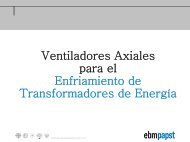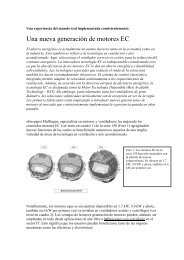Download [PDF] 2.3 MB - ebm-papst UK
Download [PDF] 2.3 MB - ebm-papst UK
Download [PDF] 2.3 MB - ebm-papst UK
You also want an ePaper? Increase the reach of your titles
YUMPU automatically turns print PDFs into web optimized ePapers that Google loves.
DIFFUSER AXITOPAxiTop – Less noise andmore efficiencyNew diffuser reduces exit losses in fansFor refrigeration and cooling equipment, theheat generated in the circulation process has tobe transferred to the ambient air via a heat exchanger.To accomplish this, fans move cool airthrough a heat exchanger and allow the heat todissipate. There is a whole range of options fordesigning and configuring especially efficient,quiet and durable fans. A new, passive component,the so-called diffuser, provides for a substantialimprovement in efficiency and noise. Itspressure-boosting effect minimises exit lossesand makes it easier to adapt the fan to commerciallyavailable heat exchangers.Ventilation and air-conditioning units usuallyrun in continuous operation, or at least with longoperating cycles. That make maximum economywith the input drive energy important, for everyadditional watt costs money and impacts the environment.For that reason, energy efficiency isan important criterion when choosing a fan. Today,statutory stipulations also play a role. Theefficient use of energy and resources is and willremain a global objective for the decades ahead.In Europe, the first tier of the ErP Directive becameeffective as of January 1, 2013. Againstthis background, it is no wonder that ultra-efficientEC technology is increasingly replacing conventionalAC technology as the fan drive of choicedue to its greater efficiency.Exit losses – the underestimated “energyguzzlers” Energy-efficient and quiet operationof the complete fan is a function of both the motorand the impeller, which the fan uses to movethe air volume needed to create the cooling airflow through the heat exchanger. Aerodynamicexpertise is needed when designing the impeller,for example to avoid separations and backflowswhich would cause both energy loss andunwanted noise. Even today, the impellers employedin the GreenTech EC fans satisfy the mostdemanding standards. But there is another pointwhich has to be taken into account when consideringthe efficiency of a fan:The inherent exit loss for fans with unimpededairflow is often an underestimated energyguzzler. Figure 1 (page 10) shows the power flowof the input drive power P o for an axial fan withunimpeded airflow. The drive power P o is split intostatic blower output (P us = product of the air flowand static pressure increase of the fan), which isof use to the user, and various losses caused by8techmag 01°2013


![Download [PDF] 2.3 MB - ebm-papst UK](https://img.yumpu.com/52907850/8/500x640/download-pdf-23-mb-ebm-papst-uk.jpg)



![[PDF] 22.3 MB - ebm-papst Argentina](https://img.yumpu.com/7645467/1/184x260/pdf-223-mb-ebm-papst-argentina.jpg?quality=85)